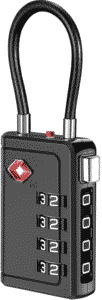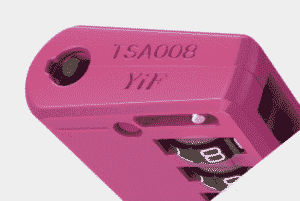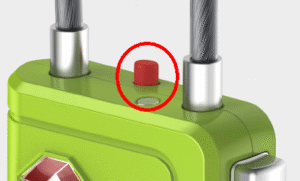
Is it a good idea to use a TSA luggage lock? Are they secure? Should you get a suitcase with a TSA lock built in, or should you use a separate TSA lock? What can you do to reduce the risk that a bad person could open the lock? What is the meaning of the red diamond logo? What features should I look for in such a lock?
In this blog article I offer answers to these questions.

Quick answers: Avoid a TSA lock that uses one of the older and smaller-numbered keys such as TSA key numbers 1 through 7. When selecting a TSA lock or a suitcase having a TSA lock, choose one that uses a more modern and less insecure key such as TSA key 8, shown at right and discussed below. Choose a lock having a “telltale” which lets you know if an airport security person has used a TSA key to open the lock or suitcase. If you pick a combination lock, consider one that has four digits rather than three.
Background. A TSA luggage lock is interesting because there are two ways to unlock it. A first way is that the traveler can unlock it using a combination known to the traveler (because the traveler had set the combination in the first place). (Some TSA locks use a key instead of a combination. It seems to me a traveler could lose or misplace such a key.) A second way is that a TSA agent can unlock it using a special TSA key.
In the old days (before 2003) there was no such thing as a TSA lock. A traveler who wished to secure his or her luggage might put a small padlock onto the luggage. A chief problem with this approach is that if an airport security person were to feel the need to inspect the luggage, there would be no choice but to cut the lock off the luggage or otherwise force the lock or suitcase open.
The idea of the TSA lock is, of course, that if a TSA agent were to feel the need to inspect the luggage, the TSA agent can simply use a special TSA key to open it. This avoids the need to cut the lock off the luggage or otherwise force the lock or suitcase open.
Is it a good idea to use a TSA luggage lock? What other choice is there (for your luggage) other than using a TSA lock? Well, you could select your own padlock and use it to lock your luggage. If you do this, it is only a matter of when, not if, some airport security person will feel the need to cut the lock off the luggage or otherwise force the lock open or force the suitcase open. So in today’s world, I see little choice but to use a TSA lock (or no lock at all).
For any non-travel application (for example a storage locker) it would be daft to use a TSA lock, for the simple reason that TSA locks are insecure, as discussed below.
Are TSA locks secure? No, TSA locks are laughably insecure. Lots of bad people have copies of at least some of the TSA keys.
Keep in mind that if somebody wants to get into your suitcase, they will succeed and it does not matter what you do. If the suitcase has a zipper, the zipper can be cut with a knife. A hard-sided bag can be jimmied open with a screwdriver or other common tools.
But for luggage, the TSA lock is better than nothing. It might keep some honest people honest. And if you were to use anything that is (supposedly) more secure than a TSA lock, it will eventually get cut off in some airport inspection or your suitcase lock will get jimmied open in some airport inspection.
Should you get a suitcase with a TSA lock built in, or should you use a separate TSA lock? There are plenty of brands and models of suitcase with built-in TSA locks. This approach has the advantage that it avoids having a dangling lock that could get caught on something.
But what if you travel to some country where the airport luggage inspectors do not have TSA keys, and what if an inspector feels the need to inspect your suitcase? If your lock is built-in, then the inspector will have to jimmy it open. On the other hand if you selected a separate TSA lock, the inspector would only need to cut off the lock, leaving your suitcase intact.
The main problem with a built-in TSA lock is that it may use one of the older and less secure keys. If your suitcase has a built-in TSA lock and if that lock uses an older TSA key, then a larger number of bad people have a key that opens your lock. And if the TSA lock in your suitcase uses an older TSA key, then the lock is easy to pick using ordinary lock picks.
If you are going to use a suitcase with a built-in TSA lock, I suggest selecting one that uses a newer and less insecure TSA key such as key 8.
If you use a separate TSA lock, then you can select a TSA lock that uses a more recently designed TSA key (such as key number 8). This more recently designed key will be in the hands of a smaller number of bad people. And the lock will be less easy to pick using lock picks.
If your existing TSA lock uses one of the older and less secure TSA keys (such as key numbers 1 through 7) then I suggest taking the lock out of service and replacing it with a TSA lock that uses a more recently designed TSA key (such as key number 8).

What can you do to reduce the risk that a bad person could open the lock? One thing that you can do to reduce this risk is to select a TSA lock that uses a more recently designed key. The photo at right shows some of the older TSA keys numbered 1 to 6. (The photo is intentionally blurred a bit for obvious reasons.) The older the key, the smaller the TSA key number. The older the key, the larger number of bad people who have a copy of the key. The older the key, the easier it is to pick the lock using ordinary lock picks.
There are many online sources for purchase of duplicates of TSA keys 2 and 7. There are online sources for purchase of other TSA keys. With a quick web search you can get data files for 3D printing of each of the older TSA keys.

The TSA locks that are the least insecure right now in 2025 are the ones that use TSA key 8. Those locks are harder to pick using lock picks, compared with smaller-numbered locks. And those keys, being newer, may have fallen into the hands of a smaller number of bad people. The lock is labeled so that the TSA agent knows which key to use. The photo at right shows a lock that uses TSA key 8. The key-8 system features a cylindrical hollow key that is not easy to duplicate.
If you select a combination TSA lock, maybe select one that uses four numerical digits instead of only three.
What about a zip tie? For a checked piece of luggage with zipper pulls, the sad fact is that a zip tie provides almost as much security as a TSA lock. The zip tie, being smaller than a TSA padlock, is less likely to get caught on something along the way.
The chief drawback to a zip tie is that you need to be able to cut it off later. Given TSA’s restrictions on things that you can bring with you on an airplane, a traveler might reach a hotel or other intermediate destination and might not be able to cut off the zip tie.
![]() What is the meaning of the red diamond logo? The red diamond is the logo of an entity called Travel Sentry. This entity has a very vague web site. You can see a Wikipedia article. It seems that this entity sets standards for TSA locks and keys, supposedly funded by licensing fees. I have to assume, however, that by now in 2025, many makers of TSA locks do not pay any fees but simply reverse-engineer and copy other licensed TSA locks.
What is the meaning of the red diamond logo? The red diamond is the logo of an entity called Travel Sentry. This entity has a very vague web site. You can see a Wikipedia article. It seems that this entity sets standards for TSA locks and keys, supposedly funded by licensing fees. I have to assume, however, that by now in 2025, many makers of TSA locks do not pay any fees but simply reverse-engineer and copy other licensed TSA locks.

What features should I look for in such a lock? Some of these TSA locks have a “telltale”. By this we mean an optical indicator that shows if the lock was opened using a TSA key. The telltale can only be reset with the user key or combination. In the photo at right, there is a small red cylinder sticking up, which for this TSA lock is the telltale in the visible position.
It seems to me that the traveler should select a TSA lock with this telltale feature.

Interesting. I would not put anything confidential to clients or containing secure credentials in checked luggage. That has to stay within my presence.
I followed you on Bluesky!